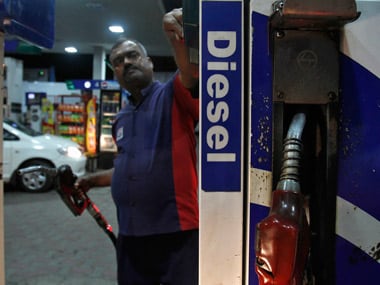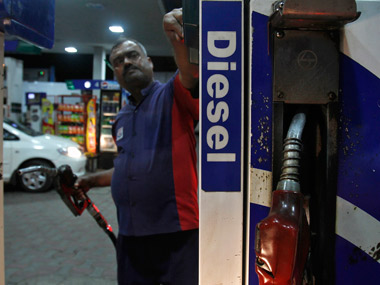New Delhi: Politics and populism have pushed the Modi government to cut the basic excise duty on petrol and diesel by Rs 2 per litre each earlier this week. Don’t mistake it for fiscal prudence; this step is in no way sensible as far as the fiscal math goes. The expected annual hit to the Central government’s revenues has been estimated at a whopping Rs 26,000 crore. But the real question now is: why are state governments hesitating in step 2, which is lowering Value Added Tax (VAT) to further reduce the end price of petrol and diesel to consumers? VAT is a major duty component adding to the end price of both petrol and diesel and varies widely across states. BJP-ruled Maharashtra levies 46.52 percent VAT (47.64 percent in Mumbai) on petrol, the highest in the country. Andhra Pradesh has 38.82 percent on petrol while BJP- ruled Madhya Pradesh levies 38.79 percent. Delhi and Himachal Pradesh levy 27 percent VAT each on petrol while Punjab charges 36.04 percent VAT. Haryana levies 26.25 percent VAT. Unless VAT is also slashed, the effective price reduction for the aam aadmi will remain puny. This piece in Times of India talks of only six BJP-ruled states may cut VAT on petrol and diesel. Kerala said a reduction was not feasible, Odisha felt the request was unjustified. Prominent BJP states like Uttar Pradesh have yet to speak out over this issue. [caption id=“attachment_3911009” align=“alignleft” width=“380”]  Representational image. Reuters[/caption] State governments are reluctant to slash VAT because obviously their finances will suffer for this populism. But consider this: the moneys they collect by taxing fuels is rarely being seen to be used for welfare schemes or infrastructure upgradation, whatever be the governments’ contentions. Besides, if the ambitious (though poorly executed) farm loan waiver schemes can be launched to gain political goodwill, why not reduce the VAT and gather some more political heft? An analysis by ratings agency CRISIL said recently that if other states also announce loan waiver schemes the way Uttar Pradesh, Maharashtra, Karnataka, and Punjab did, the collective cost to the exchequer would be about Rs 2.5 lakh crore – or 0.5 percent of GDP – per year. The cost could be significantly high for Tamil Nadu, which has the highest outstanding agricultural loans among states. Kerala, Madhya Pradesh and Rajasthan, too, could feel some pressure, the brokerage added. Surely the lowering of VAT on petrol and diesel will not punch such a big hole in the states’ finances as loan waivers! The Centre will likely reap rich dividends from this populist move in the impending polls beginning with Gujarat, states need to emulate the Centre. Without VAT reduction, the effective price difference for the consumer is less than Rs 3 per litre in each fuel, with VAT reduction this could be ramped up substantially. Whether the state governments agree with the NDA government’s move or not, whether they find it a political masterstroke by the Centre and no real immediate political gain from slashing VAT for themselves, they must fall in line. Otherwise, each state government risks being perceived as anti-people. Would these state governments, mostly non-BJP, risk being trumped by it? In the past too, getting 29 states on board with a single tax reform has been rather tough for any government holding the reins at the Centre. As of now, more than half the state government in India are either by the BJP or supported by the party. For years now, the Centre has been promising a reduction in VAT by various state governments to make flying more affordable and to also allow loss making Indian airlines to improve their margins. But the Centre’s pleas – when the Manmohan Singh government was in the saddle as well as now when Modi is in the chair – have largely fallen on deaf ears. Only now, under the UDAN scheme where state governments have to partner airlines to get flights to remote areas, have they come around with the necessary sops on ATF taxation. This story in Hindu rules out any VAT reduction by Telangana. It quotes sources to say any such move “will take its time, wait for another six months, to assess its tax revenue under the GST and also wait to see the response of neighbouring States - Andhra Pradesh, Tamil Nadu and Karnataka.” At present, VAT on petroleum products is higher in AP and slightly lower in Tamil Nadu and Karnataka compared to Telangana. With the Centre unable to persuade states to even lower VAT on the two fuels, will it find it easy to persuade the same state governments to bring these fuels under the GST regime? This piece in Hindu BusinessLine published just days before the Centre cut the basic excise duty and exhorted stated to reduce VAT, quotes a senior BJP member saying, “It is unlikely that the States – whether BJP-ruled or non-BJP — will agree (to waive the VAT component) as many of them are significantly dependent on revenues from these two products. And if they are brought under GST, the States will seek compensation for the losses; you cannot expect the States to redesign their revenue earning sources overnight.” All GST will do is bring uniformity in taxes; it will not mean taxes will come down, this piece went on to say quoting an oil industry executive. In a note to clients, analysts at brokerage CLSA said that between October 2014 and Mar 2016, the Modi government took advantage of falling crude oil prices to raise duties on petrol and diesel by Rs12 and Rs14 per litre to Rs 21 and Rs 15, respectively. These data alone go to show that the present reduction (Rs 2 per litre) is not substantial compared to the hikes effected by the government since it came to power. “The move had caused excise duty collections from petroleum products to more than double over FY15-17 to Rs 2.4 trillon or an increase of 80 basis points of GDP. The fiscal deficit fell 60 basis points during the same period. The reversal of excise duties will have an annualised 16 basis points (~8 basis points for FY18) impact on the fiscal. This comes amidst continuing uncertainties on the GST revenue front. We estimate that the central government’s share of GST collections at Rs 375 billion-425 billon/month is falling short of the targeted Rs 450 billion- 500 billion/month by Rs 70 billon-90 billion/month (~40-50 basis points annualised). Thus, concern on government revenues is likely to build-up. Lower revenues may not necessarily pass the market’s test of a government ‘stimulus’.” Be that as it may, now that Centre has bitten the bullet on excise duties, states would be foolish to hide behind fiscal compulsions and desist lowering VAT.
With the Centre unable to persuade states to even lower VAT on petrol and diesel, will it find it easy to persuade the same state governments to bring these fuels under the GST regime?
Advertisement
End of Article


)



